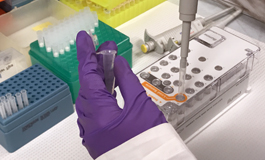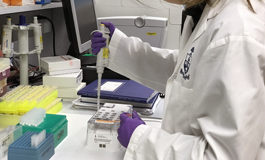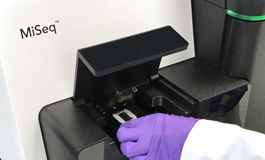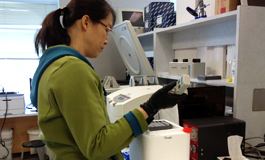






CAGEF Centre for the Analysis of Genome Evolution & Function
genome sequencing, transcriptome, microbiome, metagenome, proteomics, metabolomics






Azad MB, Konya T, Maughan H, Guttman DS, Field CJ, Chari RS, Sears MR, Becker AB, Scott JA, Kozyrskyj AL
CMAJ 2013 Feb;:
PubMed PMID: 23401405
BACKGROUND:The gut microbiota is essential to human health throughout life, yet the acquisition and development of this microbial community during infancy remains poorly understood. Meanwhile, there is increasing concern over rising rates of cesarean delivery and insufficient exclusive breastfeeding of infants in developed countries. In this article, we characterize the gut microbiota of healthy Canadian infants and describe the influence of cesarean delivery and formula feeding. METHODS:We included a subset of 24 term infants from the Canadian Healthy Infant Longitudinal Development (CHILD) birth cohort. Mode of delivery was obtained from medical records, and mothers were asked to report on infant diet and medication use. Fecal samples were collected at 4 months of age, and we characterized the microbiota composition using high-throughput DNA sequencing. RESULTS:We observed high variability in the profiles of fecal microbiota among the infants. The profiles were generally dominated by Actinobacteria (mainly the genus Bifidobacterium) and Firmicutes (with diverse representation from numerous genera). Compared with breastfed infants, formula-fed infants had increased richness of species, with overrepresentation of Clostridium difficile. Escherichia-Shigella and Bacteroides species were underrepresented in infants born by cesarean delivery. Infants born by elective cesarean delivery had particularly low bacterial richness and diversity. INTERPRETATION:These findings advance our understanding of the gut microbiota in healthy infants. They also provide new evidence for the effects of delivery mode and infant diet as determinants of this essential microbial community in early life.
Stamatiou G, Vidaurre DP, Shim I, Tang X, Moeder W, Bonetta D, McCourt P
PLoS ONE 2013;8(1):e55616
PubMed PMID: 23383246
With their unique metabolism and the potential to produce large amounts of biomass, plants are an excellent bio-energy feedstock for a variety of industrial purposes. Here we developed a high-throughput strategy, using the model plant Arabidopsis thaliana, to identify mutants with improved sugar release from plant biomass. Molecular analysis indicates a variety of processes including starch degradation, cell wall composition and polar transport of the plant hormone auxin can contribute to this improved saccharification. To demonstrate translatability, polar auxin transport in maize was either genetically or chemical inhibited and this also resulted in increased sugar release from plant tissues. Our forward genetic approach using Arabidopsis not only uncovers new functions that contribute to cell wall integrity but also demonstrates that information gleaned from this genetic model can be directly translated to monocotyledonous crops such as maize to improve sugar extractability from biomass.
Azad MB, Becker AB, Guttman DS, Sears MR, Scott JA, Kozyrskyj AL,
J. Allergy Clin. Immunol. 2013 Jan;131(1):247-8
PubMed PMID: 23199602
Johnson MT, Carpenter EJ, Tian Z, Bruskiewich R, Burris JN, Carrigan CT, Chase MW, Clarke ND, Covshoff S, Depamphilis CW, Edger PP, Goh F, Graham S, Greiner S, Hibberd JM, Jordon-Thaden I, Kutchan TM, Leebens-Mack J, Melkonian M, Miles N, Myburg H, Patterson J, Pires JC, Ralph P, Rolf M, Sage RF, Soltis D, Soltis P, Stevenson D, Stewart CN, Surek B, Thomsen CJ, Villarreal JC, Wu X, Zhang Y, Deyholos MK, Wong GK
PLoS ONE 2012;7(11):e50226
PubMed PMID: 23185583
Next-generation sequencing plays a central role in the characterization and quantification of transcriptomes. Although numerous metrics are purported to quantify the quality of RNA, there have been no large-scale empirical evaluations of the major determinants of sequencing success. We used a combination of existing and newly developed methods to isolate total RNA from 1115 samples from 695 plant species in 324 families, which represents >900 million years of phylogenetic diversity from green algae through flowering plants, including many plants of economic importance. We then sequenced 629 of these samples on Illumina GAIIx and HiSeq platforms and performed a large comparative analysis to identify predictors of RNA quality and the diversity of putative genes (scaffolds) expressed within samples. Tissue types (e.g., leaf vs. flower) varied in RNA quality, sequencing depth and the number of scaffolds. Tissue age also influenced RNA quality but not the number of scaffolds ? 1000 bp. Overall, 36% of the variation in the number of scaffolds was explained by metrics of RNA integrity (RIN score), RNA purity (OD 260/230), sequencing platform (GAIIx vs HiSeq) and the amount of total RNA used for sequencing. However, our results show that the most commonly used measures of RNA quality (e.g., RIN) are weak predictors of the number of scaffolds because Illumina sequencing is robust to variation in RNA quality. These results provide novel insight into the methods that are most important in isolating high quality RNA for sequencing and assembling plant transcriptomes. The methods and recommendations provided here could increase the efficiency and decrease the cost of RNA sequencing for individual labs and genome centers.
Chatfield SP, Capron R, Severino A, Penttila PA, Alfred S, Nahal H, Provart NJ
Plant J. 2012 Nov;:
PubMed PMID: 23181633
Adventitious shoot organogenesis contributes to the fitness of diverse plant species, and control of this process is a vital step in plant transformation and in vitro propagation. New shoot meristems (SMs) can be induced by conversion of lateral root primorida/meristems (LRP/LRMs) or callus expressing markers for this identity. To study this important and fascinating process we developed a high-throughput methodology for synchronous initiation of LRP by auxin, and subsequent cytokinin-induced conversion of these LRP to SMs. Cytokinin treatment induces expression of the shoot meristematic gene WUSCHEL (WUS) in converting LRP (cLRP) within 24-30 hours, and WUS is required for LRP-SM conversion. Subsequently, a transcriptional reporter for CLAVATA3 (CLV3) appeared 32-48 hours after transfer to cytokinin, marking presumptive shoot stem cells at the apex of cLRP. Thus the spatial expression of these two components (WUS and CLV3) of a regulatory network maintaining SM stem cells already resembles that seen in a vegetative SAM, suggesting very rapid initiation and establishment of the new SMs. Our high-throughput methodology enabled us to successfully apply a systems approach to the study of plant regeneration. Herein we characterize transcriptional reporter expression and global gene expression changes during LRP-SM conversion, elaborate the role of WUS and WUS-responsive genes in the conversion process, identify and test putative functional targets, perform a comparative analysis of domain specific expression in cLRP and SM tissue, and develop a bioinformatic tool for examining gene expression in diverse regeneration systems. © 2012 The Authors. The Plant Journal © 2012 Blackwell Publishing Ltd.
Schreiber KJ, Austin RS, Gong Y, Zhang J, Fung P, Wang PW, Guttman DS, Desveaux D
BMC Plant Biol. 2012;12:226
PubMed PMID: 23176361
BACKGROUND: The sulfanilamide family comprises a clinically important group of antimicrobial compounds which also display bioactivity in plants. While there is evidence that sulfanilamides inhibit folate biosynthesis in both bacteria and plants, the complete network of plant responses to these compounds remains to be characterized. As such, we initiated two forward genetic screens in Arabidopsis in order to identify mutants that exhibit altered sensitivity to sulfanilamide compounds. These screens were based on the growth phenotype of seedlings germinated in the presence of the compound sulfamethoxazole (Smex).
RESULTS: We identified a mutant with reduced sensitivity to Smex, and subsequent mapping indicated that a gene encoding 5-oxoprolinase was responsible for this phenotype. A mutation causing enhanced sensitivity to Smex was mapped to a gene lacking any functional annotation.
CONCLUSIONS: The genes identified through our forward genetic screens represent novel mediators of Arabidopsis responses to sulfanilamides and suggest that these responses extend beyond the perturbation of folate biosynthesis.
Ness RW, Siol M, Barrett SC
BMC Genomics 2012;13:611
PubMed PMID: 23145563
BACKGROUND: Transitions from cross- to self-fertilization are associated with increased genetic drift rendering weakly selected mutations effectively neutral. The effect of drift is predicted to reduce selective constraints on amino acid sequences of proteins and relax biased codon usage. We investigated patterns of nucleotide variation to assess the effect of inbreeding on the accumulation of deleterious mutations in three independently evolved selfing plants. Using high-throughput sequencing, we assembled the floral transcriptomes of four individuals of Eichhornia (Pontederiaceae); these included one outcrosser and two independently derived selfers of E. paniculata, and E. paradoxa, a selfing outgroup. The dataset included ~8000 loci totalling ~3.5 Mb of coding DNA.
RESULTS: Tests of selection were consistent with purifying selection constraining evolution of the transcriptome. However, we found an elevation in the proportion of non-synonymous sites that were potentially deleterious in the E. paniculata selfers relative to the outcrosser. Measurements of codon usage in high versus low expression genes demonstrated reduced bias in both E. paniculata selfers.
CONCLUSIONS: Our findings are consistent with a small reduction in the efficacy of selection on protein sequences associated with transitions to selfing, and reduced selection in selfers on synonymous changes that influence codon usage.
Peek J, Garcia C, Lee J, Christendat D
Biochim. Biophys. Acta 2013 Feb;1834(2):516-23
PubMed PMID: 23142411
The shikimate dehydrogenase (SDH) family consists of enzymes with diverse roles in secondary metabolism. The two most widespread members of the family, AroE and YdiB, function in amino acid biosynthesis and quinate catabolism, respectively. Here, we have determined the crystal structure of an SDH homolog belonging to the RifI class, a group of enzymes with proposed roles in antibiotic biosynthesis. The structure of RifI2 from Pseudomonas putida exhibits a number of distinctive features, including a substantial C-terminal truncation and an atypical mode of oligomerization. The active site of the enzyme contains substrate- and cofactor-binding motifs that are significantly different from those of any previously characterized member of the SDH family. These features are reflected in the novel kinetic properties of the enzyme. RifI2 exhibits much lower activity using shikimate as a substrate than AroE, and a strong preference for NAD(+) instead of NADP(+) as a cofactor. Moreover, the enzyme has only trace activity using quinate, unlike YdiB. Cocrystallization of RifI2 with NAD(+) provided the opportunity to determine the mode of cofactor selectivity employed by the enzyme. We complemented this analysis by probing the role of a strictly conserved residue in the cofactor-binding domain, Asn193, by site directed mutagenesis. This study presents the first crystal structure and formal kinetic characterization of a new NAD(+)-dependent member of the SDH family.
Macleod G, Varmuza S
Biochemistry 2012 Dec;51(48):9678-88
PubMed PMID: 23140390
Members of the PP1 family of protein phosphatases achieve functional diversity through numerous and varied protein-protein interactions. In mammals, there are four PP1 isoforms, the ubiquitously expressed PPP1CA, PPP1CB, and PPP1CC1, and the testis specific splice isoform PPP1CC2. When the mouse Ppp1cc gene is deleted, the only phenotypic consequence is a failure of spermatogenesis in homozygous males. To elucidate the function of the Ppp1cc gene, we sought to identify novel protein-protein interactions. To this end, we have created SBP-3XFLAG-PPP1CC1 and SBP-3XFLAG-PPP1CC2 knock-in mouse embryonic stem cell lines using a gene-trap-based system. Tandem affinity purification using our knock-in cell lines identified 11 significant protein-protein interactions, including nine known PP1 interacting proteins and two additional proteins (ATP5C1 and DDOST). Reciprocal in vitro sedimentation assays confirmed the interaction between PPP1CC2 and DDOST that may have physiological implications in spermatogenesis. Immunolocalization studies revealed that DDOST localized to the nuclear envelope in dissociated spermatogenic cells and persists throughout spermatogenesis. The knock-in system described in this paper can be applied in creating tandem affinity-tagged knock-in embryonic stem cell lines with any gene for which a compatible gene-trap line is available.